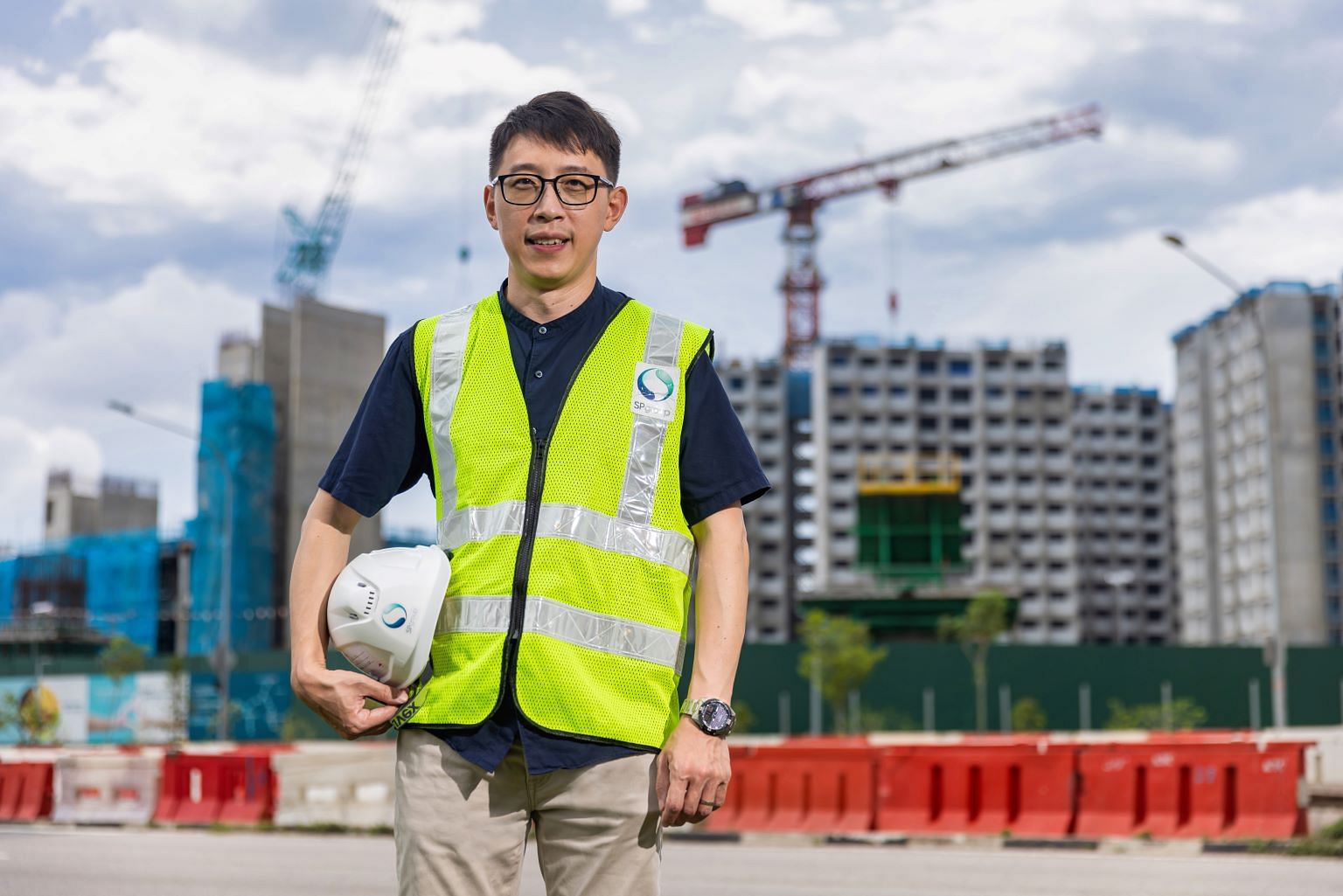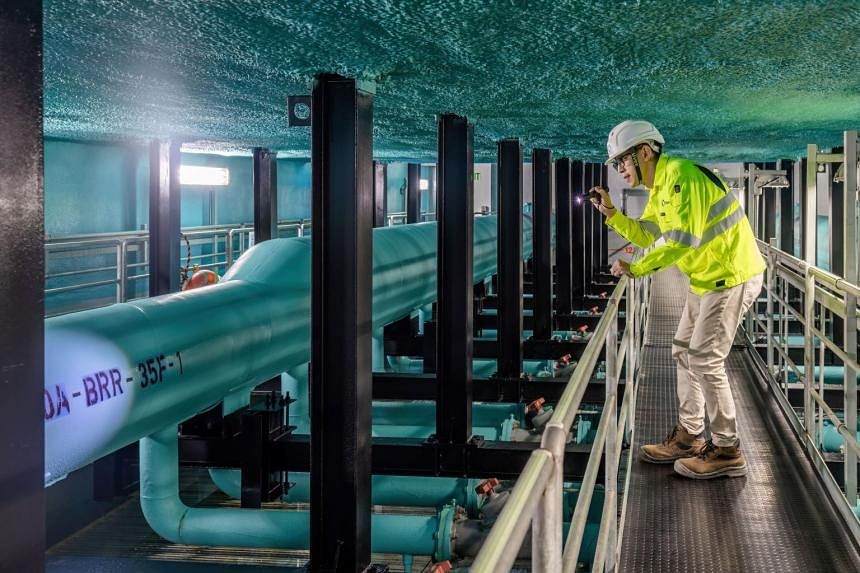Mr Liu Yue has a new engineering challenge. The 38-year-old Principal Engineer is part of the team designing and building the first centralised cooling system (CCS) for a residential estate in Singapore – in the Tengah eco-town.
Instead of individual compressor units mounted on aircon ledges, Mr Liu is tasked to build a centralised system which circulates chilled water to and from each flat to cool air within the flat, thus delivering air-conditioning service to 19,000 households in the estate. The first homes will be ready in 2023.
“It is definitely a challenge because we have to work with many other parties to overcome the space constraints,” says Mr Liu. In his previous posting in SP Group, Mr Liu worked at an underground district cooling system that serves the Marina Bay central business district. But this time, Mr Liu has to deal with space constraints of a different kind.
“In HDB flats, it’s not cost-efficient to have large underground spaces, so we have to think out of the box and find space for our cooling equipment,” Mr Liu shares.
Eventually, the project team decided to place the CCS equipment on the HDB block roof, which would allow precious ground space to be used by the community.
HDB flat rooftops would host the CCS equipment which service a cluster of HDB blocks. This arrangement would optimise the cooling output of the CCS equipment, achieving both energy efficiency and supply reliability.
Mr Liu is proud that he plays a part in transforming the energy sector to meet climate goals.
“My work helps to make essential services and utilities, which are crucial for daily life and business, more energy efficient. We are helping to improve lives by the meaningful transformation of the power industry. This brings me a lot of satisfaction as an engineer,” he says.
Reaping benefits from economies of scale
In a CCS, a few interconnected centralised plants produce chilled water which is piped to individual households. “Colder” chilled water produced at the centralised plants is circulated to the indoor air-conditioner (known as chilled water fan coil unit or FCU) in each flat. The FCU recirculates the air within the flat and cools the air. In the process, the chilled water is “warmed” up. The warmer water is then returned to the centralised plants to be chilled again and repeat the process.
Because the centralised chilled water plants are 30 per cent more energy efficient by design than individual split units found typically in households, CCS is more economical for air-conditioning of flats.

Air-conditioned comfort with lower emissions
Air-conditioning is ubiquitous in tropical Singapore. According to the Department of Statistics, about 80 per cent of Singapore households own air-conditioners, and from NEA household electricity consumption profile, air-conditioning contributes about 24 per cent of the average household electricity consumption.
With rising incomes and warming temperatures, air-conditioning ownership and the use of air conditioners are set to rise.
Worldwide, the use of air-conditioners results in the emission of nearly two million tonnes of carbon dioxide every year, or about 4 per cent of the global share. There is therefore an increasing need to reduce carbon footprint from more energy efficient air-conditioning systems.
The reduction in electricity consumption from CCS will contribute towards Singapore’s ambitious carbon footprint reduction commitments. Singapore aims to accelerate its timeline to reduce greenhouse gas emissions, peaking emissions in 2030 and achieving net-zero emissions by 2050.
While Singapore’s carbon emissions represent a small percentage of the global share (0.13 per cent in 2020), Singapore’s per capita emissions are very high, about twice the global average at 12 tonnes annually. If Singaporeans can reduce their carbon emissions significantly, it would demonstrate how people can meaningfully counteract climate change without severely lowering their standard of living.
Mr Liu is energised by his contribution to help Singapore meet its climate goals. “The CCS we are building will enable Tengah residents to lower their carbon footprint through an energy-efficient cooling system. Just by living in the estate, each resident has already started the sustainability journey. This is a huge motivating factor to every engineer working on the Tengah project.
“We started from ground zero and had our fair share of roadblocks in the journey. With all the hard work we put in, it is very rewarding to see everything come to fruition. I am glad to be able to play a part in pioneering the most futuristic town in Singapore towards smart and sustainable living. I guess it's my way of leaving my mark – a green one,” adds Mr Liu.
Energy-efficient cooling for a warming world
Leading the effort for more efficient cooling systems, SP Group will be implementing various types of cooling systems in different capacities, both in commercial and residential buildings.
Its flagship district cooling system in the Marina Bay CBD network will be expanding to cool 28 commercial buildings by 2026. The savings in electricity consumption is estimated to reduce about 20,000 tonnes of carbon emissions annually, equivalent to removing 17,672 cars off the road.
SP Group is establishing Singapore’s largest industrial district cooling system for STMicroelectronics at the Ang Mo Kio Technopark. By the time it is operational in 2025, it will reduce carbon emissions by up to 120,000 tonnes annually.
SP Group is also constructing a distributed district cooling network in Tampines, where seven existing buildings will be retrofitted by 2025.
Transitioning the world into a decarbonised future
Beyond its role as the national grid operator, SP Group actively pursues sustainability initiatives as a key part of Singapore’s climate strategy. Its climate initiatives include a nationwide electric vehicle (EV) charging network, deploying rooftop solar energy generation, and smart electricity metering to monitor and reduce usage.
SP Group has also exported these technologies to overseas markets where there is demand for sustainable energy solutions. SP Group has provided expertise to build district cooling and heating systems, smart metering and solar power generation in cities in China, Thailand and Vietnam.


